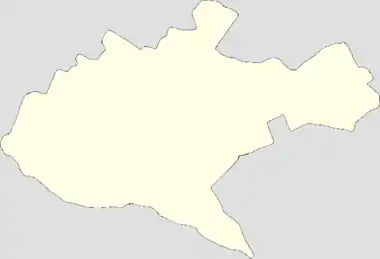| Uhuru Gardens | |
|---|---|
 Monument and flag-raising structure in the gardens | |
 Location within Nairobi County | |
| Type | Memorial |
| Location | Nairobi, Kenya |
| Coordinates | 1°19′14″S 36°47′46″E / 1.3205009°S 36.7961151°E |
| Area | 63 acres[1] |
| Opened | September 1965[1] |
| Etymology | "Freedom" (Swahili) |
| Owned by | Kenya Defense Forces[1] |
Uhuru Gardens National Monument and Museum is a commemorative park and museum in Nairobi, Kenya that celebrates independence from the British Empire in 12 December 1963.[2][3] The word "uhuru" is Swahili for "freedom".[3] It contains three points of significance:
- The Mũgumo tree (Ficus sycomorus), purportedly planted in the exact location the Union Jack, or more likely the former Flag of the Colony of Kenya, was removed and the Flag of Kenya was placed.[3] The tree is also of significance to the Kikuyu people.[4]
- The independence commemorative monument, built in 1973, is a twenty-four meter high column, supporting a pair of clasped hands and a dove of peace. This point celebrates the declaration of independence at midnight, 12 December 1963. It also celebrates the inauguration of Kenya's first president, Jomo Kenyatta, in the same night. On one side of this monument is a statue of soldiers raising the Kenyan flag.[5]
- A fountain celebrating "Twenty-Five years of Uhuru – peace, love and unity monument".[5]
References
- 1 2 3 Wambui, Mary (18 June 2022). "Uhuru Gardens: Kenya's permanent freedom museum". The East African. Retrieved 13 November 2023.
- ↑ HC Deb 22 November 1963 vol 684 cc1329-400 wherein the UK Under-Secretary of State for Commonwealth Relations and for the Colonies stated" "An agreement was then signed on 8 October 1963, providing that on the date when Kenya became independent the territories comprising the Kenya Coastal Strip would become part of Kenya proper."
- 1 2 3 "Uhuru Gardens - National Museums of Kenya". National Museums of Kenya. Retrieved 10 September 2017.
- ↑ Mũkũyũ (13 November 2008). "Gikuyu Origins". Gikuyu Architecture. Retrieved 10 September 2017.
- 1 2 "Uhuru Gardens | Enzi". www.enzimuseum.org. Retrieved 10 September 2017.
This article is issued from Wikipedia. The text is licensed under Creative Commons - Attribution - Sharealike. Additional terms may apply for the media files.